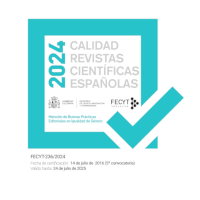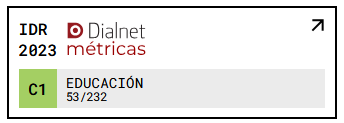Impacto de la multimodalidad en la comprensión lectora de textos narrativos en inglés como lengua extranjera (L2) en estudiantes universitarios
DOI:
https://doi.org/10.18172/con.2608Palabras clave:
Aprendizaje de lenguas extranjeras, multimodalidad, textos narrativos, comprensión lectora.Resumen
En el siguiente trabajo se busca comparar el efecto de las pruebas monomodales frente a las multimodales en el índice de comprensión lectora de textos narrativos en L2 que alcanzan los estudiantes de una universidad chilena privada. Para este efecto, se realizó un cuasi-experimento, con una prueba de comprensión lectora en formato monomodal y otra en formato multimodal, y grupos intactos. Al grupo experimental se les administró una prueba en formato multimodal, mientras que al grupo control se le administró una prueba en formato monomodal. La experiencia avala la necesidad de integrar textos multimodales en la comprensión lectora en L2. Los resultados corroboran esta hipótesis, pues, los estudiantes alcanzan niveles de comprensión más altos, en pruebas de comprensión lectora, con formato multimodal
Descargas
Citas
ALBERS, P. (2007). Visual discourse analysis: An introduction to the analysis of school-generated visual texts. En D. W. Rowe, R. T. Jiménez, D. L. Compton, D. K. Dickinson, Y. Kim, K. M. Leander, y V. J. Risko (Eds.), 56th yearbook of the National Reading Conference (pp. 81-95).
AUSUBEL, D., NOVAK, J. y HANESIAN, H. (2005). Psicología educativa. Un punto de vista cognoscitivo. México, D.F.: Trillas.
BARNETT, M. A. (1989). More than meets the eye: Foreign language reading. NJ: Pretince Hall.
BERNHARDT, E. B. (1983). Testing foreign language reading comprehension. The immediate recall protocol. Die Unterrichichtspraxis, 16, 27-33.
BERNHARDT, E. B. (1991). Reading development in a second-language. Norwood, NJ: Ablex.
CARREL, P. L. y CARSON, J. G. (1997). Extensive and intensive reading in an EAP setting. English for Specific Purposes, 16, 47-60.
CHUN, D. y PLASS, J. (1996). Facilitating Reading comprehension with multimedia. System, 24(4), pp. 503-519.
GEE, J. P. (2007). What video games have to teach us about learning and literacy. (Rev. ed.). Nueva York: Palgrave Macmillan.
HAMPEL, R. (2002). Network-based language teaching today: Multimodality, multi-dimensionality and interaction. Proceedings of the International Conference on Computers in Education (ICCE’02). The Open University, UK. Disponible en: http://csdl2.computer.org/comp/proceedings/icce/2002/1509/00/15090639.pdf.
HOSENFELD, C. (1979). A learning-teaching view of second language acquisition. Foreign Language Annals, 12, 51-54.
JEWITT, C. y KRESS, G. (2003). Multimodal literacy. Nueva York: Peter Lang.
KODA, K. (1994). Second language reading research: problems and possibilities. Applied Psycholinguistics, 15, 1-28.
KRESS, G. (2003). Literacy in the New Media Age. Cambridge: The Cromwell Press.
KRESS, G. y VAN LEEUWEN, T. (2001.) Multimodal Discourse. Londres: Arnold.
LAUFER, B. (1986). Possible changes in attitude towards vocabulary acquisition research. International Review of Applied Linguistics, 24(1), 69-75.
MATTHEWMAN, S., BLIGHT, A. y DAVIES, C. (2004). What does multimodality mean for English? Creative tensions in teaching new texts and new literacies. Education, Communication and Information, 4(1). Disponible en: http://www.interactiveeducation.ac.uk/out_mat.pdf.
MAYER, R. y SIMS, V. K. (1994). For whom is a picture worth a thousand words? Extensions of dual coding theory of multimedia learning. Journal of Educational Psychology, 86(3), 389-401.
PALINCSAR, A. S. y BROWN, A. L. (1984). Reciprocal teaching of comprehension-fostering and comprehension-monitoring activities. Cognition and Instruction, 1, 117-175.
RODRÍGUEZ, W., OCHOA, S. y PARKER, R. (2006). The crosslinguistic role of cognitive academic language proficiency on reading growth in Spanish and English. Bilingual Research Journal, 30. Disponible en: http://brj.asu.edu/vol30_no1/art5.pdf.
SCHOONEN, R., HULSTIJN, J. y BOSSERS, B. (1998). Metacognitive and language specific knowledge in native and foreign language reading comprehension: An empirical study among Dutch students in grades 6, 8 and 10. Language Learning, 48, 71-106.
SERAFINI, F. (2011). Expanding perspectives for comprehending visual images in multimodal texts. Journal of Adolescent and Adult Literacy, 54, 342-350.
SERAFINI, F. (2012). Expanding the four resources model: Reading visual and multimodal texts. Pedagogies: An International Journal, 7(2), 150-164.
SUSSER, B. y ROBB, TH. (1990). EFL extensive reading instruction: Research and procedure. JALT Journal, 12(2). Disponible en: http://www.cc.kyoto-su.ac.jp/~trobb/sussrobb.html.
WIDDOWSON, H. G. (1978). Teaching language as communication. Oxford: Oxford University Press.
WILLOWS, D. M. y HOUGHTON, H. A. (1987). The Psychology of illustration. Nueva York: Springer.
Descargas
Publicado
Cómo citar
Número
Sección
Licencia
El autor o autora conserva todos los derechos sobre su artículo y cede a la revista el derecho de la primera publicación, no siendo necesaria la autorización de la revista para su difusión una vez publicado. Una vez publicada la versión del editor el autor está obligado a hacer referencia a ella en las versiones archivadas en los repositorios personales o institucionales.
El artículo se publicará con una licencia Creative Commons de Atribución, que permite a terceros utilizar lo publicado siempre que se mencione la autoría del trabajo y la primera publicación en esta revista.
Se recomienda a los autores/as el archivo de la versión de editor en repositorios institucionales.













